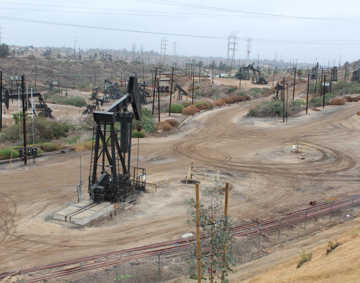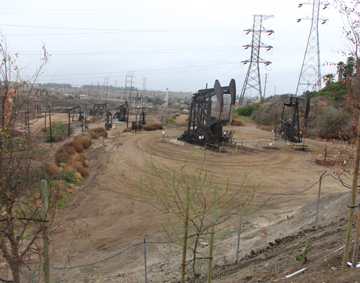 View from La Brea, between Slauson and Stocker, looking West. (Photo by David Roy.) View from La Brea, between Slauson and Stocker, looking West. (Photo by David Roy.) |
Wide open spaces are hard to come by in Los Angeles. The crowds and traffic that permeate the city make the expanse of the more than 300-acre Kenneth Hahn State Recreation Area in Baldwin Hills that much more of an anomaly. The green space, complete with walking trails, wildlife, and scenic views, sits right next to another L.A. landmark: the Inglewood Oil Field.
The oil field is more than three times bigger than the park–the 1,000-acre spread is the largest urban oil field in the country. A recent increase in activity on the oil field has some residents concerned about the health and safety risks that could come with adding more wells.
“People are running and exercising right next to active drilling without even realizing it,” says Ronda Brown. She thinks there needs to be better signage within the recreation area warning people of the proximity of the oil field. “I’m not saying people shouldn’t be allowed to go there, but they do have a right to be better informed.”
From 1980-2004 an average of 10 new wells a year were added to the field. In 2004, Texas-based oil company Plains Exploration & Production Co. (PXP) discovered more oil reserves in the field. PXP reinvigorated a drilling program on the land that many previously thought had already yielded most of its resources.
What really concerns Brown is that PXP now plans to drill 600 new wells in the next 20 years. The company has drilled 32 new wells since the beginning of 2011.
Brown vividly remembers that in 2006 drilling operations were ramped up and the release of harmful fumes forced nearby residents to evacuate their homes. The county forced PXP to stop drilling operations for six months after the accident while it worked to develop regulations. Until then, very few had been in place.
In 2008, two years after those evacuations, several community groups filed a suit against PXP. The groups settled in July of 2011. Part of the settlement includes noise limits and additional air quality monitoring.
 View from La Brea, between Slauson and Stocker, looking West. (Photo by David Roy.) View from La Brea, between Slauson and Stocker, looking West. (Photo by David Roy.) |
Despite the settlement, Brown still has concerns about the potential long-term health effects of living so close to a functioning oil field that had never been the subject of a comprehensive environmental impact report until 2008.
What Brown finds the most distressing is the lack of communication between PXP and the county and the approximately one million residents who live in the surrounding neighborhoods. She has attended several meetings of the Baldwin Hills Community Advisory Panel – a group that was formed, according to the county website, to “foster communication and ensure continued community input for the County and for PXP.”
When Brown again expressed her concerns at a community advisory panel meeting on October 27, 2011, she was told that exercising next to an oil field is no more dangerous than exercising in other parts of the city, because there’s always the potential to breathe pollution from cars or the airport.
When she asked about improved signage within the park, panel members didn’t know who was responsible to address the issue, who should be in charge of following up on the matter, or if anything could be done in regards to her concerns.
In a follow-up email with Lisa Paillet, the community advisory panel member who represents PXP, Paillet said that Baldwin Hills Conservancy Director, David McNeil offered to work with Brown. But to date, no one has contacted Brown.















Speak Your Mind